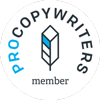How to brief a copywriter
It’s essential to brief a copywriter correctly if you want great words wrapped up in a swift service. A decent copywriting brief depends on clear communication. Namely, understanding the readership and what’s in it for them. It underscores any content, whether you’re writing about a service or a product.
What to include in a copywriter brief
Your first step in briefing a copywriter is to explain why you need the copy and the audience it’s aimed at because the writer is more likely to create accurate content in a first draft when you brief them accurately.
Second, give your copywriter an idea of the vital messages to cover, the resources they’ll receive, and the call to action. Meanwhile, provide a copy of the organisation’s tone of voice and style guide for them to study.
If you don’t have a style guide, point your copywriter to a website or publication you like and why you prefer it. Many national newspapers have theirs online. Here’s The Guardian and Observer style guide.
A brief guide to template briefs
The third tip on how to brief a copywriter is to use a template brief. The beauty of a template is that you can finesse a bit here and there to suit the subject. Moreover, you won’t reinvent the wheel when appointing the writer.
Briefs come in all shapes and sizes, but I like the formatting of these two. The top copywriting brief is from a recent marketing project. It came from a manufacturing client and covered one side of A4.
At the top of the template, it said:
Project name | Project owner | Delivery date
The client followed these three vital bits of information with six short two-line summaries. They were under these headings:
- Business need for the project
- Target audience
- Call to action
- Who to contact
- Creative copy and key messages
- Print and production details
This copywriting brief gave me all the guidance I needed in the simplest possible terms. As a result, I could get cracking straight away. A two-line introduction told me to avoid jargon and write clearly and simply. They advised imagining talking to someone new to the company. Wise words.
Another copywriter’s brief, this time for an internal communications news story for an energy company, went into more detail:
- Summary of the article and its key messages
- How it fits the company agenda
- Who to interview
- Comms team contact
- Deadline
- Approvals process
- Call to action
Experience tells me that the more information a client supplies to a copywriter up front, the easier it is to get to grips with what’s required. And the more likely you are to write to brief.
So, list the communications objective, business goal, and any crucial messages. Most importantly, list whom you want to target and the market sectors you aim for.
For clients, a well-briefed copywriter will deliver a draft right the first time, avoiding the time-consuming messiness of redrafts and the cost of rewrites.
If you have any examples of excellent briefs or any other tips on writing a good one, I’d love to receive them.




